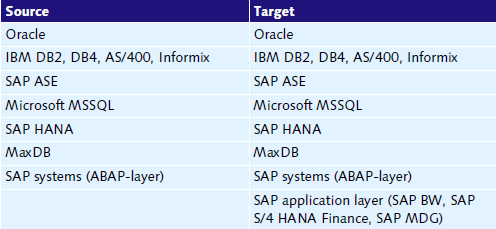TAKE NOTE (Insights into Emerging Technology)

Enterprise and software giant SAP has set a 2025 deadline after which its systems will be built to run on just one single database – SAP’s HANA.
If you use SAP’s Enterprise Resource Planning (ERP) software, and you’re not using SAP S/4HANA, you’re on a deadline. A deadline that was recently extended to 2025, but still, the clock is ticking.
SAP will continue to offer support for its ERP software until this clock runs out. But then support stops, and those businesses that want support from SAP will need to migrate to SAP’s flagship ERP software, S/4HANA.
Described by SAP as its “biggest launch in 23 years, possibly ever”, this new ERP suite will run exclusively on SAP’s own database, HANA. Previously, SAP’s software worked with a number of databases, including Oracle, but businesses migrating to the new system will also need to migrate their entire database.
SAP is keen to nudge its customers down this route, and to incentivise them it has set at 2025 deadline. Earlier this year, it announced that it had almost doubled the number of customers using S/4HANA from 5,400 to 7,900, but as the company serves over a quarter of a million businesses, it’s understandably keen to have a bigger chunk of them using their database rather than others.
What Businesses Need to Do Now… According to SAP
Is this a real deadline that businesses need to adhere to? Let’s, for a moment, assume that it is and that the only option open is to move to S/4HANA by 2025.
Even though 2025 seems quite some time away, much of the advice is to start preparing now. Smaller businesses may be able to wait a couple of years, but larger enterprises need to act now.
There are a few choices available to businesses. If the current SAP set up is not excessively customized, then it may make sense to convert to S/4HANA. If not, then a full re-implementation might be necessary. Or it may even be an opportunity to move from SAP to another provider, such as Oracle or Microsoft.
If the business decides to stick with SAP, then there will be a need for new infrastructure. S/4HANA requires HANA as a database, which in return requires Linux, the only operating system that runs HANA. The business needs to set up a proof of concept to map and prototype critical business processes that will be migrated to the new set up. They need to decide whether the infrastructure they will use will remain on-premise or move to the cloud—and whether this will be private, public, or hybrid.
The process of migration is not quick, nor easy, nor cheap. Time will need to be spent not only on the migration, but also on testing the migration, and training users on how to use the new software.
The migration may also remove one of the main advantages of SAP: its flexibility, working with the hardware and software combinations that businesses are comfortable using. HANA is an innovative “in-memory” database, making it faster—but it is nowhere near as mature as other solutions. Businesses may feel, quite rightly, that they would prefer the mature, reliable database options over the newer, if quicker, HANA database.
So, Must Businesses Really Act Now?
UNDER DEVELOPMENT (Insights into Emerging Technology)
SAP ACTIVATE – BUILD SMART RUN SIMPLE

Let’s get back to SAP and how the road map is leading us to S/4 HANA in 2025. If you use SAP’s Enterprise Resource Planning (ERP) software, and you’re not using SAP S/4HANA, you’re on a deadline. A deadline that was recently extended to 2025, but still, the clock is ticking. I figured we would start with the new methodology Activate. Its supplants the ASAP methodology.
The plan for the next few blogs are to dip into Activate, Suite on HANA, S/4 Hana, BW on Hana, and UI5 and Fiori. So lets get started!
The New SAP Activate Methodology
For many years, SAP has been a driver in developing software that improves agility, speed, and simplification. The company combined these key elements with the introduction of S/4HANA, which has led to the next evolutionary step in implementation methodology. The SAP Activate Methodology has supplanted the older ASAP methodology, and the new implementation method is now aligned with PM Body of Knowledge (PMBOK) best practices.
According to Forrester, the SAP Activate objective is to empower customers to make full use of the potential in S/4HANA and tailor is to their specific business needs. SAP Activate is the integration of 1) methodology for deployment of S/4HANA, 2) guided configuration, and 3) SAP best practices.
- The Activate methodology provides for consistent deployment regardless of mode: on-site, cloud, or hybrid. It replaces the ASAP methodology, and all new implementation methods will use the SAP Activate framework. The SAP Activate methodology focuses on an agile/lean approach, whereas the ASAP methodology was a rigid/waterfall implementation.
- The guided configuration offers a set of tools that facilitates updates and modifications to your configurations. It is offered through the Fiori application under “manage your solution.”
- SAP best practices are OLAP and OLTP processes that are optimized for S4/HANA. They address the migration and integration fundamentals and are developed to produce an optimum migration, whether you are migrating from a non-SAP database or a legacy SAP system.
The Next Generation Adaption Framework
Thus, SAP Activate represents the next generation adaptation framework, which you can use throughout each phase of an SAP life cycle. This promotes lower project costs and shorter duration with the use of accelerators that have distinct processes and steps. SAP has continuously worked to develop new approaches that speed up software deployment projects. Their innovative techniques have a specific foundation, and the SAP Activate Methodology uses this foundation and principles that are outlined below.
- Begin with best practices. Utilize Rapid Deployment Solutions, (RDS), Model Company, SAP Best Practices, and other existing assets
- Cloud ready and pre-assembled. Create an environment that promotes rapidly building solutions and uses best practices that quickens the validation activities
- ….
Dig Deeper…. Learn SAP Activate
Q&A (Post your questions and get the answers you need)

Q. SAP Seems to offer many different real-time replication tools. How do I figure out which is the right one for our company to use?
A. SAP offers several real-time replication tools, and it may be difficult for a customer to distinguish among the offerings and find the right tool or the right combination of tools that best satisfies their organization’s requirements. So let’s look at each one in turn…
SAP LT Replication Server
SLT is positioned as the standard real-time replication tool for big data for SAP ABAP-based source systems—unicode and non-unicode—to SAP HANA, to all databases supported by SAP, to the SAP Business Suite and to SAP applications. However, it also supports non-SAP sources, as listed below:

SAP Replication Server (formerly Sybase Replication Server)
Although the SAP Replication Server is a real-time replication tool for non-SAP source systems, it also supports the SAP Business Suite 7.20 and higher (Unicode-only). Supported source databases are shown below:

SAP HANA Smart Data Integration
SAP HANA Smart Data Integration (SDI) is a real-time replication and ETL tool from both SAP and non-SAP sources, replicating exclusively to a single SAP HANA instance.
SAP Data Services
SAP Data Services is positioned for all bulk batch ETL scenarios from both SAP and non-SAP application sources where real-time replication is not required, writing not only to SAP HANA and other supported databases, but also to files (comma delimited, fixed width, COBOL, XML, and Microsoft Excel). SAP Data Services can be combined with SLT to retrieve delta data in real-time. This is called changed-data capturing.
Each tool has it pros and cons, like the SRS faces issues while reading Pool and Cluster tables. But HANA does not use these table types anyway. Also SRS does not support filtering or transformation of data.
Because you asked this question, odds are you needed help on moving data into HANA. Deciding on the right tools is always desperately challenging. It’s a strategic shift, which always takes time.
Start slowly but begin on your decision process now. Is the tool in line with your ongoing project’s deeper objective or not?
Good luck!


